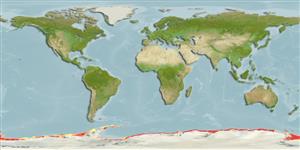>
Perciformes/Notothenioidei (Icefishes) >
Nototheniidae (Cod icefishes) > Trematominae
Etymology: Trematomus: Greek, trematos = hole + Greek, tomo = section, cut (Ref. 45335); lepidorhinus: lepidorhinus from Greek, lepido means scale; rhinus means snout (Ref. 11892).
Issue
The genus Pseudotrematomus is a synonym of Trematomus, which is confirmed by a molecular study to be published (J.-C. Hureau, pers. comm. 08 Jun. 2010).
Environment: milieu / climate zone / depth range / distribution range
Ökologie
seewasser bathydemersal; tiefenbereich 200 - 800 m. Deep-water; 60°S - 78°S, 180°W - 180°E
Southern Ocean: inner slope and continental shelf of Antarctica, except the Antarctic Peninsula. Two specimens are reported from South Orkney islands.
Size / Gewicht / Alter
Maturity: Lm ? range ? - ? cm
Max length : 31.0 cm TL Männchen/unbestimmt; (Ref. 5179); max. veröff. Gewicht: 276.30 g (Ref. 124149)
Kurzbeschreibung
Morphologie | Morphometrie
Rückenflossenstacheln (insgesamt): 6 - 7; Rückenflossenweichstrahlen (insgesamt): 31-33; Afterflossenweichstrahlen: 34 - 36. Brownish with irregular indistinct darker crossbars, spinous dorsal blackish. Mouth and branchial cavities blackish (Ref. 11892).
Adults feed on amphipods (mostly Themisto gaudichaudii), copepods, polychaetes, and mysids.
Dewitt, H.H., P.C. Heemstra and O. Gon, 1990. Nototheniidae. p. 279-331. In O. Gon and P.C. Heemstra (eds.) Fishes of the Southern Ocean. J.L.B. Smith Institute of Ichthyology, Grahamstown, South Africa. (Ref. 5179)
IUCN Rote Liste Status (Ref. 130435)
Bedrohung für Menschen
Harmless
Nutzung durch Menschen
Fischereien: nicht kommerziell
Mehr Information
PartnerBilderStamps, Coins Misc.LauteCiguateraGeschwindigkeitSchwimmstilKiemenoberflächeOtolithsGehirngrößeSehfähigkeit
Tools
Zusatzinformationen
Download XML
Internet Quellen
Estimates based on models
Preferred temperature (Ref.
123201): -1.8 - 1.1, mean -0.9 °C (based on 763 cells).
Phylogenetic diversity index (Ref.
82804): PD
50 = 0.5005 [Uniqueness, from 0.5 = low to 2.0 = high].
Bayesian length-weight: a=0.00427 (0.00285 - 0.00639), b=3.22 (3.10 - 3.34), in cm total length, based on LWR estimates for this species & Genus-body shape (Ref.
93245).
Trophic level (Ref.
69278): 3.8 ±0.2 se; based on diet studies.
Widerstandsfähigkeit (Ref.
120179): mittel, Verdopplung der Population dauert 1,4 - 4,4 Jahre. (Fec = 2,200).
Fishing Vulnerability (Ref.
59153): High vulnerability (62 of 100).
Nutrients (Ref.
124155): Calcium = 24.9 [14.7, 63.2] mg/100g; Iron = 0.463 [0.191, 0.925] mg/100g; Protein = 17.2 [16.1, 18.3] %; Omega3 = 0.406 [0.222, 0.713] g/100g; Selenium = 14.9 [6.1, 36.2] μg/100g; VitaminA = 29.1 [6.2, 142.1] μg/100g; Zinc = 0.473 [0.306, 0.729] mg/100g (wet weight); based on
nutrient studies. 